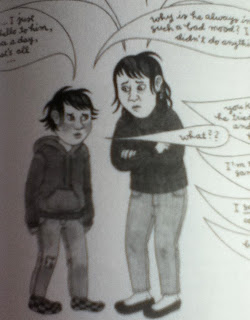In her graphic novel Susceptible, Genevieve Castree has created a fictionalized autobiography in two separate editions, French and English. Goglu, the central character, has been drawn in lovely brush washed ink to resemble Castree's self-portraits (which can be seen here on her blog). Her style is a little like Mary Engelbreit's, with big eyes and lots of intricate patterns, but her story is sometimes harrowing. Goglu, btw, is the French word for a bobolink (and Castree is also a musician).
The opening four pages are the most metaphorical of the book. Goglu muses about her mental health and whether or not her depressions are innate, inherited or acquired as a result of life's difficulties. She shows herself growing from babyhood into adulthood while being gradually consumed by vegetation, then breaking free of the plants. "I have pulled myself so far away from my family that it is almost like I don't belong to it anymore." According to her interview in Comics Journal, this corresponds to Castree's real life.
I love all the detail in Castree's realistic images. The fourteen women massacred at the Ecole Polytechnique are each shown as individuals, with their own tastes in clothing and hair, as they lie dead together. When a panel is text-heavy, the background is usually plain, but the figures remain specific; messy hair, expressive faces, particular clothing. In the scene below, Goglu is wearing the kind of chequered knitted slippers that I remember being popular at that time. (I still have a pair.)
Goglu's mother and stepfather are called Amere and Amer, the feminine and masculine words for bitterness. They qualify for a worst parents award. Amere is an alcoholic with wild mood swings. Amer is so disengaged that he is irritated by any interaction from talkative Goglu, even a simple greeting. During one of their many bouts of marital disagreement, Amere and Amer tell Goglu that they have decided to break up. Amer says, "We don't want you to think that this is all your fault... it's half your mother's fault and half your fault..."
Goglu's birth father Tete d'oeuf (Egghead) abandoned their family in Quebec and moved to Vancouver Island, so he didn't have much to do with her until she was a teenager. When Goglu visits him in Malahat, she experiences the shock of difference between city life and Tete d'oeuf's tiny house in the forest. The interior and exterior settings in both places add to the realism of Castree's poignant story. As with the women who were massacred, Castree illustrates her father's cats as individuals.
Since I read this back-to-back with The Cats of Tanglewood Forest, I compared Castree's cats to those of Charles Vess. Castree's cats look like Japanese art while Vess' remind me of classic children's picture books from the western hemisphere. I like them both.
 |
| Two-page spread by Charles Vess in The Cats of Tanglewood Forest. |




No comments:
Post a Comment